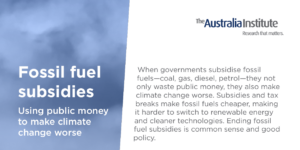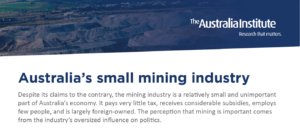The economic impacts of Australia’s mining expansion: Quick links to TAI research
The Australia Institute (TAI) has been researching the economic impacts of mining activity in Australia. This document provides a brief summary of key facts and links to TAI research papers, policy briefs and submissions currently available online.
Key facts
- Mining ‘crowds out’ other industries: The expansion of mining causes a contraction in non-mining industries, particularly manufacturing, tourism, agriculture and education. This results in business closures and job losses.
- Mining is a small employer: Mining is highly mechanised and employs few people relative to other industries. It employs only around 2% of the Australian workforce.
- Mining is a poor taxpayer: The effective corporate tax rate for mining is 13.9%, well below the industry average of 21%.
- Mining is highly subsidised: Every year the Commonwealth Government subsidises the mining industry by at least $4 billion dollars.
- Mining is 83% foreign owned.
- Mining did not ‘save’ Australia from the GFC: Mining shed 15% of its employees within 6 months of the GFC. If the rest of the economy had behaved the same way, Australia would have experienced 19% unemployment.
TAI Research Papers
Click on the title below to download the full report. All are available at www.tai.org.au.
| Title | Focus | Key Messages |
|---|---|---|
| Mining the Truth: The rhetoric and reality of the commodities boom By David Richardson and Richard Denniss |
Economic impacts of Australia’s resource boom. |
|
| Too much of a good thing? The macroeconomic case for slowing down the mining boom By Richard Denniss and Matt Grudnoff |
The speed of mining development and Australia’s national interest. |
|
| Mining Australia’s Productivity: The role of the mining industry in driving down Australia’s productivity growth By David Richardson and Richard Denniss |
Mining sector influence on Australia’s labour productivity figures. |
|
| Job creator or Job destroyer? An analysis of the mining boom in Queensland By Matt Grudnoff |
Economic impacts of mining in Queensland. |
|
| Pouring Fuel on the Fire: The nature and extent of Federal Government subsidies to the mining industry By Matt Grudnoff |
Subsidies to the mining industry from the Federal Government. |
|
| Beating Around the Bush: The impact of the mining boom on rural exports By Matt Grudnoff |
Impacts of the mining boom on Australia’s agricultural sector. |
|
| Still Beating Around the Bush: The continuing impacts of the mining boom on rural exports By Matt Grudnoff |
Impacts of the mining boom on Australia’s agricultural sector. |
|
| An analysis of the impacts of the China First mine By Richard Denniss |
Impacts of the mining boom on manufacturing and other non-mining industries. |
|
| An analysis of the economic impacts of Arrow Energy’s Gladstone LNG Plant By Matt Grudnoff |
Impacts of the mining boom on manufacturing and other non-mining industries. |
|
| James Price Point: An economic analysis of the Browse LNG project By Matt Grudnoff |
Impacts of the West Australian Government and Woodside’s proposal for an LNG precinct in the Kimberley region. |
|
| Measuring Fugitive Emissions: Is coal seam gas a viable bridging fuel? By Matt Grudnoff |
Fugitive emissions from coal seam gas. |
|
| CSG economic modelling: On the alleged benefits of the Santos coal seam gas project in North West NSW By David Richardson |
Impacts of the Santos coal seam gas project in North West NSW. |
|
Additional resources
You can download additional resources including a Mining the Truth fact sheet and presentation slides at www.tai.org.au/resources.
If you would like to arrange a ‘Mining the Truth’ presentation in your area or order hard copies of Mining the Truth contact us on the details below. TAI is also able to arrange training workshops in delivering the Mining the Truth presentation, or in understanding economic arguments more broadly.
Contact
Mark Ogge, Public Engagement Officer, The Australia Institute
M. +61 421 272 884 | E. mark@tai.org.au
Related documents
Between the Lines Newsletter
The biggest stories and the best analysis from the team at the Australia Institute, delivered to your inbox every fortnight.
You might also like
Fossil fuel subsidies
When governments subsidise fossil fuels—coal, gas, diesel, petrol—they not only waste public money, they also make climate change worse. Subsidies and tax breaks make fossil fuels cheaper, making it harder to switch to renewable energy and cleaner technologies. Ending fossil fuel subsidies is common sense and good policy.
Why a fossil fuel-free COP could put Australia’s bid over the edge
When the medical world hosts a conference on quitting smoking, they don’t invite Phillip Morris, or British American Tobacco along to help “be part of the solution”.
Australia’s small mining industry
Despite its claims to the contrary, the mining industry is a relatively small and unimportant part of Australia’s economy. It pays very little tax, receives considerable subsidies, employs few people, and is largely foreign-owned.


